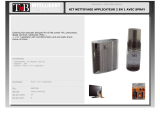Earlex SPRAY PORT HV 7000 User manual
- Category
- Paint Sprayer
- Type
- User manual
This manual is also suitable for
Earlex SPRAY PORT HV 7000 is a highly versatile spray kit intended for use by professionals. It is a portable system that can be broken down into two separate parts, the main Turbine Unit and the Carrier Stand. These two parts connect together via two quick-release clips allowing the complete system to be wheeled from a vehicle to the workplace or around the workshop. It is easy to use, very safe, and reduces the amount of paint used. It can be used with several different spray mediums including varnishes, wood preservatives, enamels, oil, and water-based paints, and cellulose.
Earlex SPRAY PORT HV 7000 is a highly versatile spray kit intended for use by professionals. It is a portable system that can be broken down into two separate parts, the main Turbine Unit and the Carrier Stand. These two parts connect together via two quick-release clips allowing the complete system to be wheeled from a vehicle to the workplace or around the workshop. It is easy to use, very safe, and reduces the amount of paint used. It can be used with several different spray mediums including varnishes, wood preservatives, enamels, oil, and water-based paints, and cellulose.












-
 1
1
-
 2
2
-
 3
3
-
 4
4
-
 5
5
-
 6
6
-
 7
7
-
 8
8
-
 9
9
-
 10
10
-
 11
11
-
 12
12
Earlex SPRAY PORT HV 7000 User manual
- Category
- Paint Sprayer
- Type
- User manual
- This manual is also suitable for
Earlex SPRAY PORT HV 7000 is a highly versatile spray kit intended for use by professionals. It is a portable system that can be broken down into two separate parts, the main Turbine Unit and the Carrier Stand. These two parts connect together via two quick-release clips allowing the complete system to be wheeled from a vehicle to the workplace or around the workshop. It is easy to use, very safe, and reduces the amount of paint used. It can be used with several different spray mediums including varnishes, wood preservatives, enamels, oil, and water-based paints, and cellulose.
Ask a question and I''ll find the answer in the document
Finding information in a document is now easier with AI
Related papers
-
Earlex 0SS77USSG Installation guide
-
Earlex HV7000 User manual
-
Earlex 6900 Operating Instructions Manual
-
Earlex 0HV6003PUS User manual
-
Earlex HV7000A User manual
-
Earlex 0HV6003PUS Installation guide
-
Earlex V0053 User manual
-
Earlex HV5500US User manual
-
Earlex Pro-8 Spray Gun Owner's manual
-
Earlex 0HVGEMUS Operating instructions
Other documents
-
 T'nB NEEC006 Datasheet
T'nB NEEC006 Datasheet
-
Prepac WEB-1664 User guide
-
WAGNER 0529003 Operating instructions
-
BLACK DECKER HVLP400 Owner's manual
-
WAGNER PaintReady Station Sprayer User manual
-
Titan Flexspray Handheld Owner's manual
-
Ronix 1395 User manual
-
Graco 3A3109G, ToughTek® F340e Portable Fireproofing Pump User guide
-
King Canada 8199 User manual
-
Camfil G12 Owner's manual












